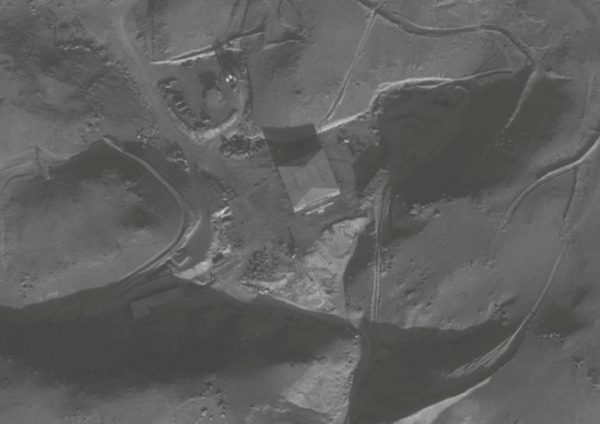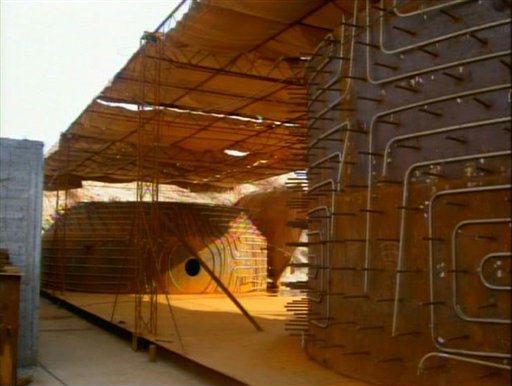Earlier this month, Israel lifted an 11-year gag order forbidding any mention of having successfully bombed a Syrian nuclear reactor in Deir Ezzor in September 2007. While numerous international news outlets have written extensively about the operation over the years, this recent release marks the first time that Israel has formally acknowledged its role in ending Basher Assad’s quest for atomic capabilities.
The successful operation was inspired by a previous failure on the part of Israeli security forces. Back in 2003, when Muammar Qaddafi publicly agreed to dismantle his nuclear arsenal, Israel was shocked to learn that the Libyan dictator was in possession of nuclear arms in the first place. Despite its extensive intelligence gathering apparatus across the region, Israel had not ascertained this knowledge regarding Qaddafi—nicknamed the “Mad Dog of the Middle East.”
“On December 19, 2003, a Saturday morning, I turned on the radio and heard on a news broadcast that the Americans and the British had persuaded Libya to dismantle its nuclear program,” former senior Mossad intelligence officer Amnon Sufrin told the Israeli Haaretz daily.
“The next morning I assembled my people and I said we had experienced two total failures here: We’d had absolutely no idea that such a program even existed and, second, we didn’t know that negotiations to dismantle it had been going on for eight months,” recalled Sufrin. “We started to back-analyze the Libyan program and try to figure out where else in the region similar programs could be hiding.”
Stung by the failure, Israeli intelligence decided to study whether any of its other enemies had developed under-the-radar nuclear programs. Both the Mossad espionage agency and the IDF military intelligence’s research division quickly homed in on a small building in the middle of the desert, near the eastern Syrian city of Deir Azzor.
“We had satellite pictures of a large building in the middle of the desert, with no explanation,” said then-Military Intelligence Chief Amos Yadlin.

Nicknamed “The Cube” by analysts, the 17,200-square-foot building was almost totally inaccessible, and was connected to a cooling system hooked up to the Euphrates river. A cooling system is a vital component of a nuclear reactor, and taken as strong evidence that Syrian President Bashar Assad had embarked on a secret quest to go nuclear.
“You don’t see what is happening inside. It is far from any settlement,” said Sufrin. “There is no reason for anyone to be in this area except for herdsmen. We began to suspect that there, in broad daylight, a reactor was hiding.”
The next breakthrough was supplied by a covert Mossad operation, in which agents broke into the Vienna hotel room where Syrian Atomic Energy Commission head Ibrahim Othman was staying, and drained all of the contents of his personal computer. They discovered a gold mine of information: Othman’s computer held 35 photographs in what was clearly a North Korean-style, plutonium-based nuclear reactor. Othman was also seen hobnobbing with senior North Korean nuclear scientists, and the newly acquired intelligence convinced Israelis that Syria was working towards weapons which could destroy tiny Israel overnight.

“Syria is building in its territory a nuclear reactor for the production of plutonium, with North Korea, which according to [initial] rigorous assessment is liable to be operational in about a year. To our assessment [redacted] it is clandestine and meant to achieve a nuclear weapon,” read an urgent memo written by IDF military intelligence.
At this stage, it was clear to the Israeli leadership that the reactor needed to be destroyed. Under the “Begin Doctrine”—so named for former Prime Minister Menachem Begin, who had bombed Iraq’s Osiraq nuclear reactor in 1981— Israel will not allow any of its enemies to acquire nuclear weapons that could devastate Israel, a nation smaller than the size of New Jersey.
Then-Prime Minister Ehud Olmert decided to bring the United States into the picture. In early 2007, Olmert sent his Defense Minister to update U.S. Defense Secretary Robert Gates. The Bush administration, still reeling from faulty intelligence regarding Saddam Hussein’s nonexistent WMD program, was hesitant to believe the Israeli intelligence. In order to supply substantial proof that the building in Deir Azzor was indeed a nuclear reactor, Israel dispatched its elite Sayeret Matkal special operations unit to infiltrate Syria. Dressed in Syrian army uniforms, the Sayeret Matkal forces managed to collect soil samples from the site, despite being spotted by Syrian troops. U.S. tests found that the samples showed extraordinary amounts of radiation, all but verifying Israel’s claims.
The resulting debate split the Bush administration into several factions. Vice President Dick Cheney found himself alone in advocating for the U.S. to bomb the reactor, with the intent of sending a clear message to Iran. “I again made the case for U.S. military action against the reactor. Not only would it make the region and the world safer, but it would also demonstrate our seriousness with respect to non-proliferation…but I was the lone voice. After I finished, the president asked, “Does anyone here agree with the vice president?” Not a single hand went up around the room,” Cheney wrote in his autobiography.
Cheney’s approach was hotly contested by Secretary of State Condoleezza Rice, who advocated turning to the United Nations Security Council. Israelis deemed the plan unacceptable—they feared that the slow-moving diplomatic approach would enable Assad to stall for time and let the reactor go “hot”.
The Israelis, meanwhile, pressed the U.S. to bomb the reactor before it would become operational. Bush denied this request, telling Olmert that as the United States was occupied in Iraq and Afghanistan, it was loath to open up a new front in Syria. Bush made it clear, however, that he was not opposed to the Israelis bombing Syria on their own. “Prime Minister Olmert hadn’t asked for a green light, and I hadn’t given one. He had done what he believed was necessary to protect Israel,” Bush later wrote in his book “Decision Points”.
The Israelis decided to bomb the reactor themselves after hearing reports that the existence of the site had been leaked to the American media. The best pilots in the Israeli Air Force were handpicked for an operation so secret that many of the pilots were only informed of the target shortly before the mission commenced. “They didn’t know the target; they didn’t understand why. In every squadron there was only one pilot who was the contact person. The other teams were only informed of the target just a few hours before the operation,” recalled Israeli Air Force Chief Major General Amikam Norkin.

After intense debate within the security cabinet, Olmert approved the aerial assault, but decided to keep the raiding force deliberately low-key in order to prevent humiliating Syrian President Bashar Assad—the aim was to avoid a harsh reaction that could deteriorate into all-out war. On September 6, 2007, eight F16I and F15I fighter jets took off from a base in southern Israel. After a few hours of flying low to avoid detection by radar, the jets homed in on the target and released 17 tons of explosives. The entire structure was destroyed. In footage released on Wednesday by the IDF, the tense generals can be seen exulting in the IDF War Room after receiving word that the nuclear reactor no longer existed.
The assault was made possible by Israel’s world-class cyber warfare capabilities. According to numerous reports, Israel hacked Syrian air defenses during the operation, causing radar to show empty skies over Syria during the attack.
The attack was seen as an incredible success in Israel, who was still licking its wounds from the IDF’s subpar performance in the 2006 Second Lebanon War. Security officials appreciate the bombing even more in hindsight, when ISIS later controlled Deir Azzor for over three years.
Official reaction from Syria was muted. Israel’s conclusion that limiting the attack would avoid a war was proven correct, as the Assad government never responded to the operation. As part of its policy of restraint, Israel did not admit its involvement until recently, 11 years after the military censor forbade news outlets from reporting on the matter.
Senior Israeli officials hinted that the decision to declassify the operation was intended as a warning to Iran. “The message from the 2007 attack on the reactor is that Israel will not tolerate construction that can pose an existential threat,” said IDF Lt. Gen. Gadi Eisenkot.“This was the message in 1981, this is the message in 2007 and this is the future message to our enemies.”
